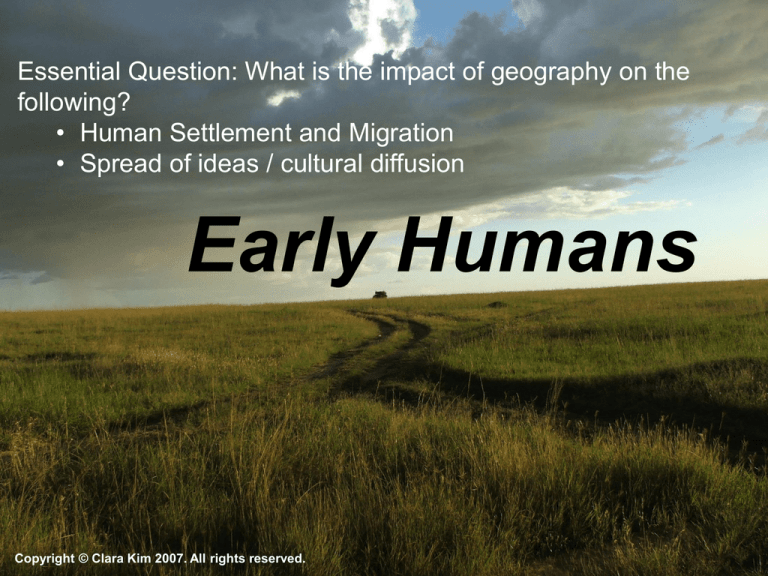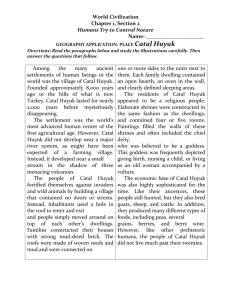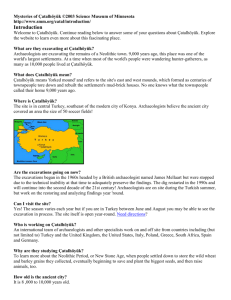
Essential Question: What is the impact of geography on the
following?
• Human Settlement and Migration
• Spread of ideas / cultural diffusion
Early Humans
Copyright © Clara Kim 2007. All rights reserved.
Australopithecines
• 1st to grow the
opposable
thumb
Censored
•First humanlike
creature to walk
upright
How it all began…
• Homo Sapiens (modern
humans) appeared in
Africa 100,000 to
400,000 years ago.
• Then migrated to
–Europe
–Asia
–Australia
–The Americas
How did they find their food?
• Early human societies
met their needs by
hunting animals and
gathering other foods
like edible plants.
• These hunters and
gatherers were also
known as nomads.
Nomads
• Nomads: People who depend on wild
plants and animals to survive. They
followed where the food supply went
and gathered seeds and nuts.
HUMAN LIFE IS SPLIT
INTO
TWO PERIODS!
TO BE CONTINUED…
Road to the Agricultural
Revolution
Paleolithic to Neolithic Era
Copyright © Clara Kim 2007. All rights reserved.
Prehistory
• Prehistoric or Prehistory – refers
to the time before the
advancement of writing.
Paleolithic Era
• Paleolithic Era
also means Old
Stone Age.
• The Paleolithic
or old stone age
began 2 million
years go.
Paleolithic Era
• Homo Sapiens during
this period were:
– Nomads
– The first to make
simple tools and
weapons.
– Make cave art
– Master the use of Fire.
– Develop a language
– Living in clans
Neolithic Era
• Neolithic Era also
means the new
stone age.
Homo Sapiens during
this period:
• Developed agriculture
• Domesticated animals
• Used advanced tools like spears
• Developed weaving skills
The Agricultural Revolution
• The Neolithic Age is
sometimes called
the Agricultural Age
• Nomads turned to
Farmers
• They learned to
domesticate (tame)
animals
• They learned to farm
their food
What did it all lead to?
• All of these developments led to the
rise of settlements and agriculture.
• This advanced homo sapiens towards
civilization.
Neolithic Age
• Mastered the art of farming,
had complex societies & created
armies to protect walled cities
• One early city - Catal Huyuk,
located in present day Turkey.
• They built mud-brick homes. Catal
Huyuk means Forked Mound.
• High point from 6700 to 5700 B.C.
Archaeological excavation
and conservation by an
international team started in
1993 under the direction of
Dr Ian Hodder of the
Çatalhöyük Research Project,
Stanford University.
Residents entered cities with ladders.
Catal Huyuk could have looked
similar to this graphic.
Lineage Groups or
Kinship Units traced
descendants through
Matrilineal or Patrilineal
2 Early Neolithic Towns
Catal Huyuk
& Jericho
Catal Huyuk
Art Forms
Jericho: It is also believed to be the
oldest continuously inhabited city in
the world.
MANKIND 1
The Five Features of
a Civilization
Copyright © Clara Kim 2007. All rights reserved.
Advanced Cities
• In order to be
considered a city
it must have:
–1. Large
population
–2. Must be a
center of
TRADE
Complex Institutions
• Institution – a long
lasting pattern of
organization in a
community such
as
– Government
– Religion
– Economy
Technology
• New tools and
techniques that
solve problems
and make life
easier
Specialized Workers
• Specialized
means
someone
has the skills
to do a
specific kind
of work
Record Keeping
• Must have a
developed system
of writing so the
people can:
– Record business
– Write a set of laws
– Priests can record
rituals and dates
Pneumonic Device
• Ants
– Advanced Cities
• Can’t
– Complex Institutions (government,
religion)
• Take
– Technology
• Slick
– Specialized workers
• Rice
– Record Keeping
MANKIND Pt 2
Pictures Cited
•
•
Slide 3 – http://www.davidmacd.com/images/new_york/100_7303_busy_broadway.jpg
Slide 4 – http://studentwebs.coloradocollege.edu/~c_belle/religion.jpg,
http://www.nationwideshelving.com/images/shelving_storage_products/shelving_by_industry/gove
rnment_
•
•
•
Slide 5 – clipart
Slide 6 – http://www.uwm.edu/People/closs/images/firefighters1024_768.jpg
Slide 7 – http://www.barrattschapel.org/images/museumpicts/journal.jpg
Pictures Cited
•
•
•
•
•
•
•
Slide 2 - http://cavemanchemistry.com/ch120slides/graphics/cartoon/7.png
Slide 3 - http://raconter.net/img/write.jpg
Slide 4 - http://www.accd.edu/sac/vat/arthistory/arts1303/Paleohorse3.jpg
Slide 5 - http://youth.crosspointelive.org/uploaded_images/bonfire-748725.jpg
Slide 6 - http://www.svf.uib.no/sfu/blombos/Artefact_Review1_Images/images/Bigbifacials-&-scrapers.jpg
Slide 7 - clipart
Slide 8 - http://www.sewerhistory.org/images/w/wam/moh_wam14.jpg
Pictures Cited
•
•
•
•
•
•
•
•
•
•
Slide 1 – www.baylor.edu
Slide 2 - http://www.classicalvalues.com/NYPair.jpg, www.museumstorecompany.com
Slide 3 - http://www.geocities.com/latrinchera2000/archivoimagenes/hominizacion/habilis/habilis6.jpg
Slide 4 - http://teachersnetwork.org/powertolearn/web/Prehistory%20Web%20Quest/images/Homo_Erectus.gif
Slide 5 - www.ugopozzati.it/images/Speranza-Neanderthal.jpg
Slide 6 - http://www.astrosurf.com/luxorion/Bio/cro-magnon-caverne.jpg
Slide 7 - http://www.izea.net/images/africa.gif
Slide 8 - www.rim101.net/pictures/xrm0101b.jpg
Slide 9 - http://www.princetonfamilycenter.org/images/cavemen.jpg
Slide 10 - www.preceptaustin.org








